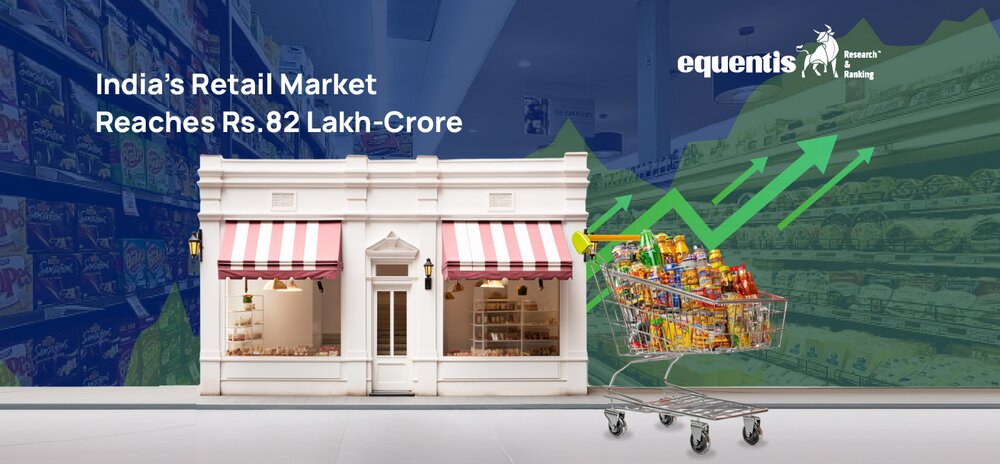India’s retail market has experienced remarkable growth over the past decade, expanding from ₹35 lakh crore in 2014 to ₹82 lakh crore in 2024, reflecting an annual growth rate of approximately 8.9%.
This growth highlights India’s economic progress and rising consumer spending. The retail sector is set to expand further, with estimates suggesting it could exceed ₹190 lakh crore by 2034.
A report titled “Winning in Bharat: The Retail Kaleidoscope” by Boston Consulting Group (BCG) and the Retailers Association of India (RAI) attributes this growth to India’s strong economy and its diverse, evolving consumer base. Economic Times
This growth offers huge opportunities for retailers who can understand India’s diverse shoppers and changing buying habits.
4 key Factors Driving India’s Retail Growth
Several key elements have contributed to this robust expansion:
- Economic Prosperity: India’s consistent GDP growth has elevated disposable incomes, enabling increased consumer spending across various retail segments. The number of affluent households in India is expected to triple by 2030, creating significant opportunities in premium and luxury retail segments.
dtnext.in - Urbanization: The rapid shift towards urban living has driven the growth of modern retail stores, offering city shoppers more convenience and variety.
- Evolving Consumer Demographics: The increasing participation of women in the workforce and the prominence of Gen Z and millennials are reshaping consumption patterns, leading to heightened demand in categories like beauty, personal care, and fashion.
dtnext.in - Digital Adoption: The expansion of urban centers and the rise of digital technology are shaping shopping habits as consumers embrace online and offline retail experiences. The report also emphasizes the increasing significance of an omnichannel approach fueled by the growth of digital payments and online shopping. However, more than 58% of purchases still occur in physical stores.
Know More: SEBI Registered investment advisory | Stock investment advisory
Global Influence Meets Local Pride
Global trends and brands increasingly inspire Indian consumers. However, a strong sense of local pride also influences purchasing decisions and brand preferences. The report highlights that retailers who understand and adapt to India’s diverse demographics and contrasting consumer behaviors will have the greatest growth opportunities.
Retailers that combine deep consumer insights with sharp execution—whether online, offline, or both—can keep up with India’s rapid retail expansion and set new benchmarks for the next decade of growth.
Opportunities and Challenges
The path forward is filled with both opportunities and challenges:
- Tier II and III Cities: These regions are emerging as new retail hubs, contributing over 50% of e-commerce transactions. Consumers in these areas exhibit a blend of aspirations and value-consciousness, prompting brands to expand aggressively beyond metros.
- Omnichannel Strategies: The modern Indian consumer no longer distinguishes between online and offline shopping. Retailers are adopting omnichannel strategies, integrating physical stores with digital platforms to provide a seamless shopping experience.
- Sustainability: With rising environmental consciousness, consumers actively seek eco-friendly products and ethical sourcing. Brands launching recyclable packaging and sustainable supply chains are attracting environmentally conscious shoppers.
Economic Times Retail
Conclusion
India’s retail market is set to grow further, with estimates suggesting it could cross ₹190 lakh crore by 2034—more than double its current size. This growth offers huge opportunities for retailers who can adapt to India’s diverse consumers and changing shopping habits.
Reaching ₹82 lakh crore in 2024 shows the retail sector’s strength and ability to adapt. As it grows further, businesses must stay flexible, inclusive, and innovative to meet the needs of India’s diverse and ever-changing consumer base.
Related Posts
Disclaimer Note: The securities quoted, if any, are for illustration only and are not recommendatory. This article is for education purposes only and shall not be considered a recommendation or investment advice by Equentis – Research & Ranking. We will not be liable for any losses that may occur. Investments in the securities market are subject to market risks. Read all the related documents carefully before investing. Registration granted by SEBI, membership of BASL & certification from NISM in no way guarantee the performance of the intermediary or provide any assurance of returns to investors.
FAQs
What are the primary drivers propelling India’s retail market from ₹82 Lakh Cr to ₹190 Lakh Cr by 2034?
Key factors include E-commerce expansion, rising disposable incomes, urbanization, and a young, tech-savvy population. Increased internet penetration fuels online shopping, while higher incomes boost discretionary spending. Urban migration concentrates on consumers, and a youthful demographic embraces modern retail formats and digital platforms, driving substantial growth.
How does e-commerce contribute to this projected retail market expansion?
E-commerce democratizes access, reaching remote areas and offering vast product ranges. Digital payment adoption simplifies transactions, and personalized online experiences enhance customer engagement. Logistics improvements ensure faster deliveries, while competitive pricing attracts budget-conscious consumers. This convenience and accessibility significantly expand the market reach, contributing to the projected growth.
How does rising disposable income impact India’s retail sector growth?
Increased disposable income allows consumers to spend more on non-essential goods and services. This drives demand for premium products, fashion, electronics, and lifestyle experiences. The growing middle class seeks better quality and brand experiences, leading to higher average spending per customer and boosting overall retail revenue.
How does urbanization influence the projected retail growth in India?
Urbanization concentrates populations, creating dense consumer markets. This fosters the development of organized retail formats like malls and supermarkets. Improved infrastructure and connectivity in urban areas facilitate efficient supply chains and logistics. The concentration of consumers also attracts investments in retail infrastructure and modern shopping experiences.
What role does India’s young, tech-savvy population play in this retail growth?
India’s youthful demographic readily adopts digital technologies, driving online shopping and digital payments. Their preference for convenience and personalized experiences fuels demand for e-commerce and omnichannel retail. They are early adopters of new trends and brands, influencing broader market dynamics and accelerating retail sector growth.
How useful was this post?
Click on a star to rate it!
Average rating 0 / 5. Vote count: 0
No votes so far! Be the first to rate this post.
waitfor delay '0:0:5'--
I’m Archana R. Chettiar, an experienced content creator with
an affinity for writing on personal finance and other financial content. I
love to write on equity investing, retirement, managing money, and more.
 Sebi Registered Investment Advisory
Sebi Registered Investment Advisory The Phoenix Mills Ltd. (PDF)
The Phoenix Mills Ltd. (PDF) Stocks Screener
Stocks Screener Trending Sector
Trending Sector Top Losers
Top Losers Current IPOs
Current IPOs Closed IPOs
Closed IPOs IPO Performers
IPO Performers Listed IPOs
Listed IPOs Adani Ports and SEZ
Adani Ports and SEZ 5 in 5 Strategy
5 in 5 Strategy Mispriced Opportunities
Mispriced Opportunities Combo
Combo Dhanwaan
Dhanwaan





















